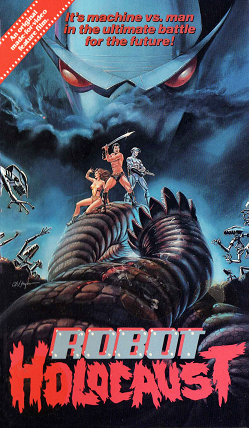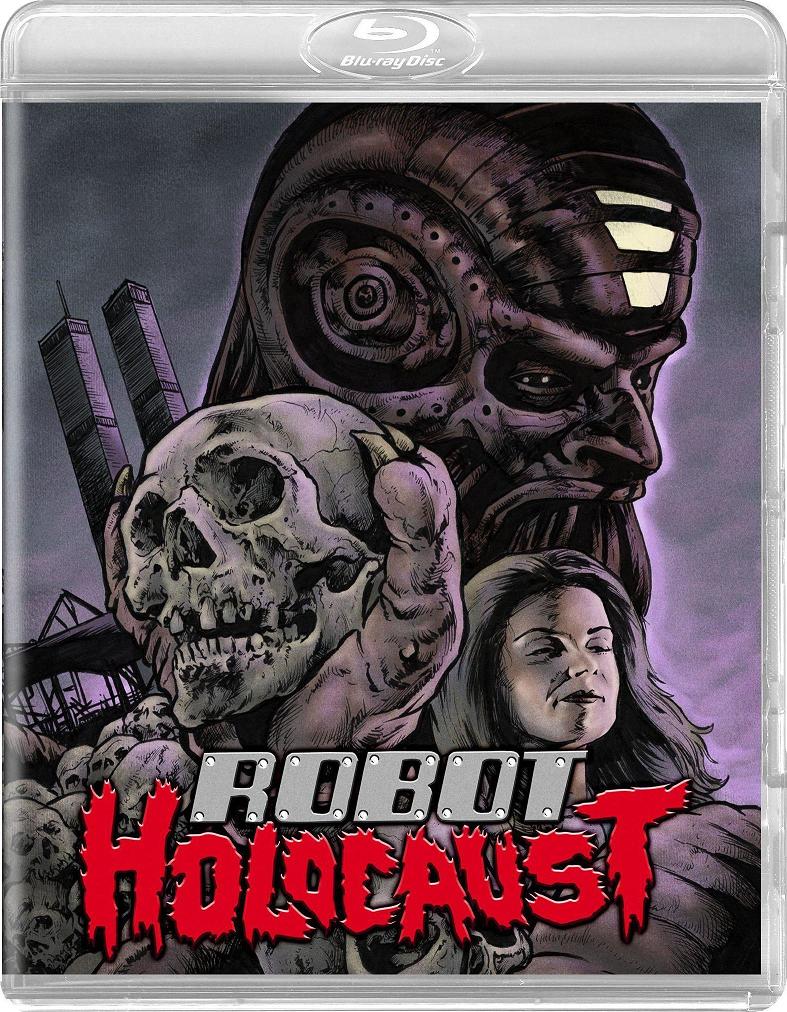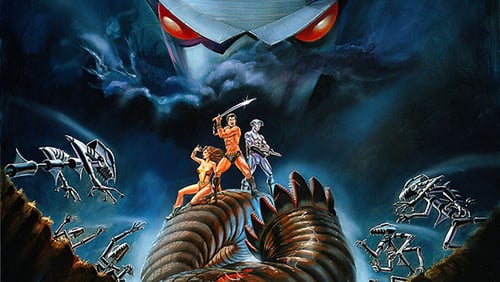Video Violence is a weekly column dedicated to genre films recently released to home video. This week’s column takes a look at Wizard Video extravaganza ROBOT HOLOCAUST.

The Movie:
In a dystopian wasteland still smoldering from a horrific war with sentient robots, a freedom-fighter named Neo leads a rag-tag rebellion against humanity’s mysterious, brutal overlords. Sure, we all saw this story in 1999 when The Wachowskis called it THE MATRIX, but what about when Tim Kincaid did it with (much) less money and called it ROBOT HOLOCAUST thirteen years earlier? Another one of those 1980s American-Italian co-productions that feels like someone ran down a list of movies to rip off, ROBOT HOLOCAUST is a gleeful sugar rush of mutants, badass beefcakes, killer babes, and robot mayhem. Maybe it’s more appropriate to say this production feels more like a kid channel surfing through all the best parts of several movies with an itchy remote control finger at the ready whenever it looks like things are going to get too boring. This is what happens when someone makes a movie with the intention of only including “the good stuff,” with pesky things like exposition and character developments taking a backseat and staying there for the duration.
Okay, that’s not entirely true: Kincaid does have the decency to treat us to an expository prologue that actually feels more like a trailer. Shots of desolate, empty landscapes (read: Central Park littered with trash) linger on screen as a gravelly voice somberly informs us of the robot rebellion that caused this irradiated hellscape, a “world that has been brought to its knees by… the ROBOT HOLOCAUST.” Cue the blaring synthesizer and the killer on-screen title. Even this only takes all of one minute before the audience is dropped right into the middle of a gladiatorial bout, a contest held at the behest of the mysterious “Dark One” who lords over the wasteland. It’s here that we also meet Neo (Norris Culf) and his robot sidekick, who arrives just in time for a chance encounter with Deeja (Nadine Hartstein), a prisoner whose father has invented a device that could free Earth’s slaves from the Dark One’s grip.
There’s some nonsense about how The Dark One — who only exists in the film as a disembodied voice speaking through a glowing orb — controls the air everyone breathes, with the exception of a select few like Neo. Honestly, it’s not terribly important; what is important is that Neo agrees to this quest, eventually enlisting an Amazon warrior (Jennifer Delora) and her mute captive (Andrew Howarth) as part of his crew to march on The Dark One’s obvious matte painting lair in an effort to topple the overlord.
Once the quest begins in earnest, ROBOT HOLOCAUST is free to be the best version of itself that it can possibly be on a budget that sensible folks might have wisely invested in a house, a car, or higher education. Not Tim Kincaid, though, and bless him for it. Obviously, his resources aren’t on par with the aforementioned MATRIX (or, hell, most movies with this kind of scope), but his enthusiasm is just as boundless, even if it is consistently undercut at every turn by cheap effects, wooden actors, and a virtually nonexistent script. If it sounds like I’m exaggerating about the latter, please consider that 75% of ROBOT HOLOCAUST involves Neo and his compatriots wandering through the Dark One’s vacant warehouse lair, encountering various deathtraps, creatures, robots and mutated minions.
The only problem is that maybe it’s a half-step up from your average roadside carnival funhouse, right down to the way each new obstacle has a name like “The Vault of Beasts.” I half-expected one of the Dark One’s stooges to blindfold the heroes, run their hands through a bowl of spaghetti, and tell them it’s actually disemboweled intestines. Less problematic: to this day, even as a grown-ass man, I would pay my hard-earned money to stroll through one of these ramshackle haunts, so ROBOT HOLOCAUST carries the same mystical charm of the type of place that promises giant spiders and maybe delivers a “leg” made out of pipe cleaner.
Kincaid does what he can to realize something a little bit more impressive than that, but his film largely in that spirit: he envisions a sweeping, epic journey through the wasteland, only to deliver the quaintest post-apocalypse landscape imaginable. Most of his meager budget seems to have made its way into the production design, which boasts some genuinely cool creatures, robots, and even a smattering of gore. What’s most important is that ROBOT HOLOCAUST rarely lacks for action: It seems like there’s always something lurking around the corner for the group to battle, even if most of them can’t even convincingly wield their weaponry. Hell, some of them can barely walk convincingly.
This — and the other 25% of ROBOT HOLOCAUST that doesn’t involve Neo’s group hacking, slashing, and shooting their way through bad guys — is what has made the film so notorious since its release. Whenever the film does slow down to advance the skimpy plot, it’s often done with an awkward patchwork of repetitive dialogue and the worst voiceover narration this side of the theatrical cut of BLADE RUNNER. Inane plot developments emerge in a desperate attempt to explain how a group of misfit warriors could possibly topple the supreme Dark One, a being omnipotent enough to literally control the air everyone breathes. He’s unable, however, to realize when his human slaves are duping him by pretending to power his enormous facility.
It turns out there’s a good reason for that. You see, despite being an omnipotent warlord, he employs a one-woman security detail in Valaria (Angelika Jager), a ditz who spends most of the running time screwing everything up. Her job mostly entails peering into a security monitor to track Neo’s progress and dispatching minions that fail each and every time. In what quickly turns into a comedy routine, Valaria continues to assure The Dark One of her foolproof plans, only to see them blow up spectacularly. Contrary to his reputation as a ruthless ruler, The Dark One keeps giving her more chances, each one coming with vague threats and electrocution.
Jager’s performance will rewire your brain and cause you to reconsider the binary notions of “good” and “bad.” Affecting an accent that lands somewhere between “vaguely Eastern European” and “Valley Girl,” she threatens to devour every bit of the scenery (all $79 of it) on her way to becoming the most indelible thing about ROBOT HOLOCAUST. Several times, she recites her dialogue, then bounds off-screen as if she were part of a stage production, a nice little touch that captures the charming ineptness on display throughout the film. Everything about Jager’s presence suggests she was mostly hired on her ability to fill out her pseudo-dominatrix getup and her willingness to step into The Dark One’s “Pleasure Machine,” which just looks like a phone booth that’s been specifically designed for gratuitous nude scenes.
Of course, that’s exactly the sort of priorities you’d expect from a film that eventually wound up under the banners of both Empire Pictures and Wizard Video, two pillars of VHS-era schlock. ROBOT HOLOCAUST does them proud, at least in terms of effort and pacing — especially the pacing. Rarely has a 79-minute runtime felt so crucial as it does here: if nothing else, someone involved recognized the limits of ROBOT HOLOCAUST, wisely determined to deliver the bare minimum amount, then let Wizard’s signature big box art do the rest to draw in an unsuspecting audience. Video store patrons may have thought they were getting some insane hybrid of STAR WARS and CONAN THE BARBARIAN; what they actually got was closer to a half-baked, heavily improvised game of DUNGEONS & DRAGONS that somehow willed itself onto celluloid.

The Disc:
ROBOT HOLOCAUST went straight to video in 1986, then almost immediately became MST3K fodder just a few years later, allowing its legend infamy to grow. Despite this exposure, however, the original, unriffed film itself has never been available on DVD or Blu-ray until Scorpion Releasing finally did the honors a few months ago. The niche label skipped DVD altogether by offering a solid Blu-ray release that’s light on supplements but quite solid in terms of presentation. Sporting an HD restoration and lossless audio, it’s safe to say ROBOT HOLOCAUST has never been seen in such pristine condition. Shaking off the VHS-era murkiness and low-grade resolution reveals a film that sports some nice color and details in its production design despite its meager budget.
The lone supplement is a seventeen-minute interview with Delora, who plays the man-hating Amazon warrior. Her recollections paint to be exactly the sort of scrappy, lo-fi production you might expect, which explains some of the film’s eccentricities and gaffes. She’s quite fond of her experience on the film, and speaks glowingly of the cast and crew, particularly Kincaid. Besides an exclusive slipcover, only other “supplements” are trailers for other Scorpion releases, meaning this isn’t the most robust edition. It is, however, safe to assume this is the best it’s going to get for ROBOT HOLOCAUST, one of the most unlikely films to even crawl onto Blu-ray in the first place.
I’d be lying if I said this one was better without the Satellite of Love Crew, but that’s a stretch: it’s more worthwhile to track down that particular edition (Volume XXV) unless you are a true ROBOT HOLOCAUST devotee. (In which case, congratulations: This has got to be a hell of a time for you.)
Tags: Andrew Howarth, Angelika Jager, Blu-ray, Charles Band, Columns, Cynthia De Paula, Empire Pictures, Jennifer Delora, Nadine Hartstein, Norris Culf, Richard Band, scorpion releasing, The 1980s, Tim Kincaid, VHS, Video Violence, Wizard Video


No Comments